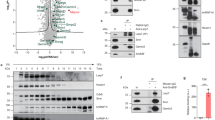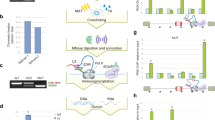Abstract
Diverse classes of noncoding RNA, including small nuclear RNAs (snRNAs), play fundamental regulatory roles at many stages of gene expression. For example, recent studies have implicated 7SK RNA and components of the splicing apparatus in the regulation of transcriptional elongation. Here we present the first evidence of the involvement of an snRNA in the regulation of transcriptional initiation. We demonstrate that TFIIH, a general transcription initiation factor, specifically associates with U1 snRNA, a core-splicing component. Analysis of the TFIIH-dependent stages of transcription in a reconstituted system demonstrates that U1 stimulates the rate of formation of the first phosphodiester bond by RNA polymerase II. In addition, a promoter-proximal 5′ splice site recognized by U1 snRNA stimulates TFIIH-dependent reinitiation of productive transcription. Our results suggest that U1 snRNA functions in regulating transcription by RNA Polymerase II in addition to its role in RNA processing.
This is a preview of subscription content, access via your institution
Access options
Subscribe to this journal
Receive 12 print issues and online access
$189.00 per year
only $15.75 per issue
Buy this article
- Purchase on Springer Link
- Instant access to full article PDF
Prices may be subject to local taxes which are calculated during checkout





Similar content being viewed by others
Accession codes
References
Eddy, S.R. Nature Rev. Genet. 2, 919–929 (2001).
Nguyen, V.T., Kiss, T., Michels, A.A. & Bensaude, O. Nature 414, 322–325 (2001).
Yang, Z., Zhu, Q., Luo, K. & Zhou, Q. Nature 414, 317–322 (2001).
Fong, Y.W. & Zhou, Q. Nature 414, 929–933 (2001).
Proudfoot, N.J., Furger, A. & Dye, M.J. Cell 108, 501–512 (2002).
Yudkovsky, N., Ranish, J.A. & Hahn, S. Nature 408, 225–229 (2000).
Feaver, W.J. et al. Cell 79, 1103–1109 (1994).
Orphanides, G., Lagrange, T. & Reinberg D. Genes Dev. 10, 2657–2683 (1996).
Coin, F. & Egly, J.M. Cold Spring Harb. Symp. Quant. Biol. 63, 105–110 (1998).
Brinster, R.L. et al. Proc. Natl. Acad. Sci. USA 85, 836–840 (1988).
Palmiter, R.D. et al. Proc. Natl. Acad. Sci. USA 88, 478–482 (1991).
Maldonado, E., Drapkin, R. & Reinberg, D. Methods Enzymol. 274, 72–100 (1996).
LeRoy, G. et al. J. Biol. Chem. 273, 7134–7140 (1998).
Akoulitchev, S., Makela, T.P., Weinberg, R.A. & Reinberg, D. Nature 377, 557–560 (1995).
Drapkin, R. et al. Proc. Natl. Acad. Sci. USA 93, 6488–6493 (1996).
Kumar, K.P., Akoulitchev, S. & Reinberg, D. Proc. Natl. Acad. Sci. USA 95, 9767–9772 (1998).
Moreland, R.J. et al. J. Biol. Chem. 274, 22127–22130 (1999).
Efstratiadis, A. et al. Cell 21, 653–668 (1980).
Johnson, T.L. & Abelson, J. Genes Dev. 15, 1957–1970 (2001).
Stevens, S.W. et al. Mol. Cell 9, 31–44 (2002).
Crispino, J.D., Blencowe, B.J. & Sharp, P.A. Science 265, 1866–1869 (1994).
Hirose, Y. & Manley, J.L. Genes Dev. 14, 1415–1429 (2000).
Tian, H. FEBS Lett. 509, 282–286 (2001).
Holstege, F.C., Fiedler, U. & Timmers, H.T. EMBO J. 16, 7468–7480 (1997).
Tirode, F., Busso, D., Coin, F. & Egly, J.M. Mol. Cell 3, 87–95 (1999).
Kim, T.K., Ebright, R.H. & Reinberg, D. Science 288, 1418–1422 (2000).
Liu, J. et al. Cell 104, 6353–6327 (2001).
Furger, A., O'Sullivan, J.M. Binnie, A., Lee, B.A. & Proudfoot, N.J. Genes Dev. in the press (2002).
Cuello, P. et al. EMBO J. 18, 2867–2877 (1999).
Lee, J.M. & Greenleaf, A.L. J. Biol. Chem. 272, 10990–10993 (1997).
Acknowledgements
We thank A. Catchpole and A. Taylor for help with snRNA cloning, and T. Harder, P. Uguen, P. Cook, O. Bensaude, J. Manley and D. Reinberg for helpful discussions and reagents. A.A. is supported by the Wellcome Trust Career Development Fellowship and by grants from Cancer Research UK and the Edward Abraham Research Fund.
Author information
Authors and Affiliations
Corresponding author
Ethics declarations
Competing interests
The authors declare no competing financial interests.
Rights and permissions
About this article
Cite this article
Kwek, K., Murphy, S., Furger, A. et al. U1 snRNA associates with TFIIH and regulates transcriptional initiation. Nat Struct Mol Biol 9, 800–805 (2002). https://doi.org/10.1038/nsb862
Received:
Accepted:
Published:
Issue Date:
DOI: https://doi.org/10.1038/nsb862
This article is cited by
-
In vivo measurements reveal a single 5′-intron is sufficient to increase protein expression level in Caenorhabditis elegans
Scientific Reports (2019)
-
Trichoderma virens β-glucosidase I (BGLI) gene; expression in Saccharomyces cerevisiae including docking and molecular dynamics studies
BMC Microbiology (2017)
-
Deep intronic mutations and human disease
Human Genetics (2017)
-
Binding of the 7SK snRNA turns the HEXIM1 protein into a P-TEFb (CDK9/cyclin T) inhibitor
The EMBO Journal (2004)



